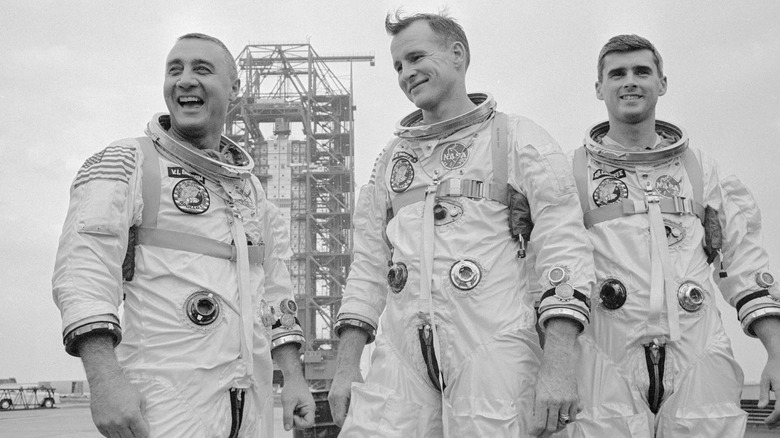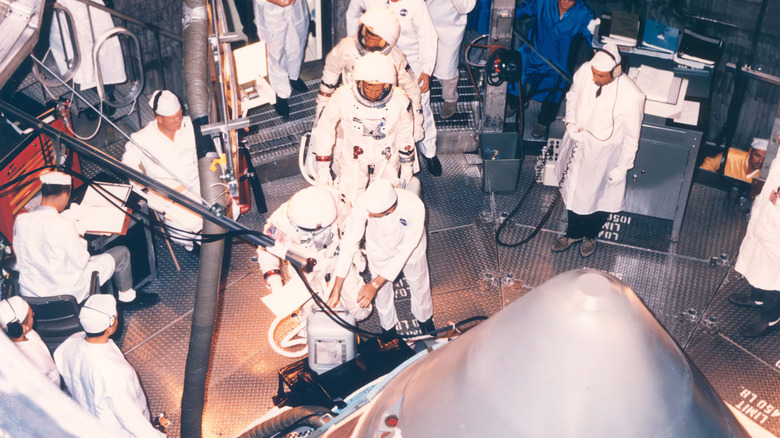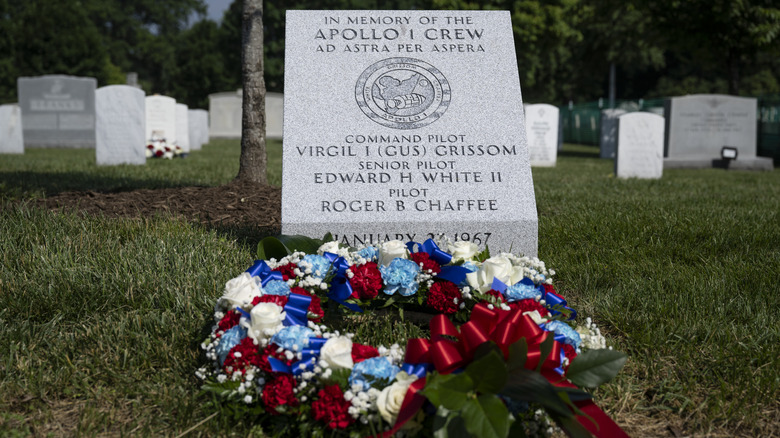What Happened To The Bodies Of The Apollo 1 Crew?
When thinking of space-related disasters, many people's minds might go to the 1986 Challenger mission that saw seven crew members die after their shuttle ignited during liftoff. But nearly 20 years prior in 1967 another accident took the lives of three men — Virgil "Gus" Grissom, Edward H. White, and Roger B. Chaffee — before they even reached the sky. Like the later Challenger explosion, mechanical error was to blame. And like the crew of the later Challenger mission, these three men didn't die immediately.
On January 27, 1967, the crew of the Apollo 1 mission — formally the Apollo 204 mission — was carrying out training procedures inside their command module at the Cape Canaveral Launch Complex 34 ahead of their February 21 launch. At about 6:30 p.m. a fire broke out on their launch pad while they were inside the module and devoured their oxygen. By the time emergency crews got to the scene and gained access to the craft, the three men inside had asphyxiated. Investigations revealed that "technical and management lapses" had caused the fire, as NASA reports.
Multiple memorial services from January 29 through 31 honored the men and their sacrifice. Their three bodies had been recovered from the craft intact and were buried at individual funerals: Grissom and Chaffee at Arlington National Cemetery and White at West Point Military Academy. A memorial in honor of the three of them, meanwhile, sits at West Point. It was only recently commemorated on June 2, 2022.
Death by asphyxiation via toxic gas
Virgil "Gus" Grissom, Edward H. White, and Roger B. Chaffee accounted for three of seven total accidental deaths leading up to the 1969 moon landing. Each one had a life and story, such as Grissom's wife Betty working late as a telephone operator to help put her husband through college on the G.I. Bill while he studied mechanical engineering.
When the fire broke out under the astronauts' craft, Chafee got on the radio and said, "Hey, we're burning up," as The New York Times cites. White opened the hatch to escape, but by then the interior of the craft had been flooded with pure oxygen at a pressure slightly higher than Earth's atmosphere. As a result, the fire underneath the craft ate through the oxygen-rich air inside, and the three men asphyxiated before they could be rescued. Their burns, it's reported, were survivable.
After the accident the men's bodies were transported to a nearby medical facility. Photographers took pictures of the scene and the astronauts inside their vessel, but these photos have thankfully never been released. Per NASA, autopsies conducted by the Air Force recorded "asphyxia from carbon monoxide and other toxic gases resulting from the fire" as the men's official cause of death.
On The New York Times, Sonny Witt, 45th Space Wing director of operations for Division 1 at Patrick Air Force Base, said of the astronauts' families, "They are the ones that lost the husbands and brothers and fathers. Mistakes were made, and they paid the price."
Buried and memorialized
As mentioned, the three Apollo 1 astronauts were buried in two separate cemeteries. Virgil "Gus" Grissom and Roger B. Chaffee were interred at Arlington National Cemetery in Arlington, Virginia right next to each other in Section 3. Edward White was buried separately at the West Point Post Cemetery in West Point, New York, in Section 18. Such decisions would have been up to the men's family members.
There's a communal memorial for Grissom, Chafee, and White at Arlington National Cemetery, as well. The Latin inscription on the memorial reads "Ad Astra per Aspera," meaning, "A rough road leads to the stars." And indeed, even though the Apollo 1 crew never had the chance to leave orbit, their legacy did lead to the stars. Two years later the 1969 Apollo 11 mission saw the first humans set foot on the moon.
Besides the crew's graves and memorial, Launch Complex 34 at Cape Canaveral still stands to this day as another memorial. The austere, weather-stained concrete box serves as a stark reminder of the tragedy that happened at that very spot some 57 years ago as of this writing. Per Florida Today, Grissom's younger brother Lowell describes mixed feelings about the site — a bit of anger, a bit of sadness, and a bit of pride. Former space shuttle engineer Mark Poff, meanwhile, applauds the lost crew as "superstars." The Astronauts Memorial Foundation — the group that heads up services at Launch Complex 34 — hopes to expand its annual service to members of the general public.


